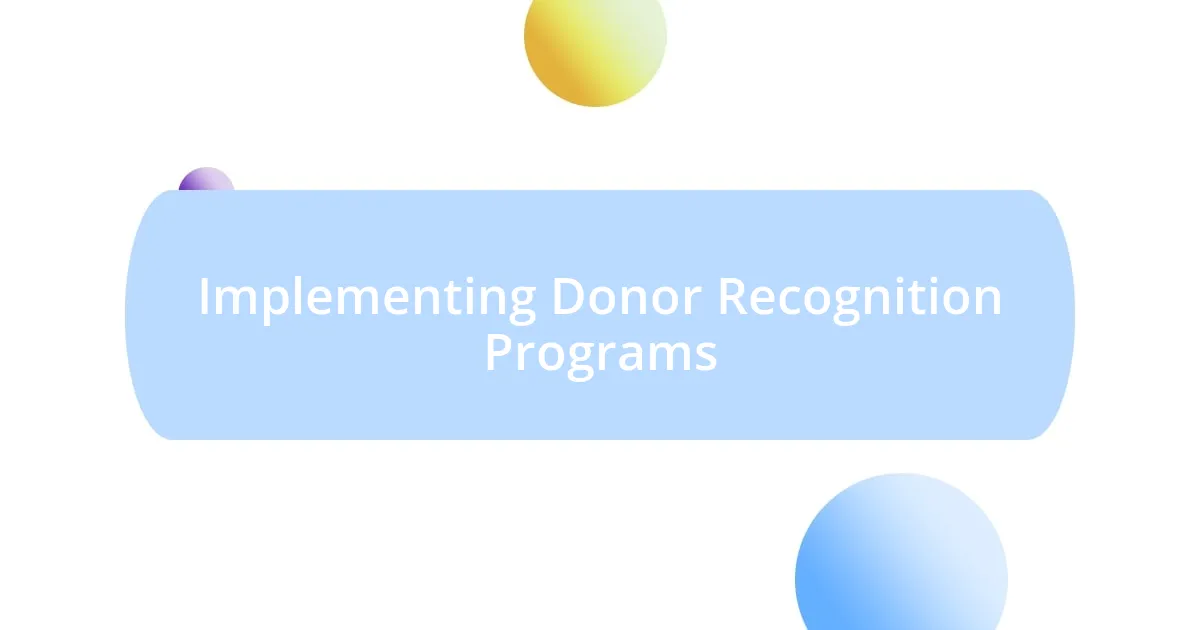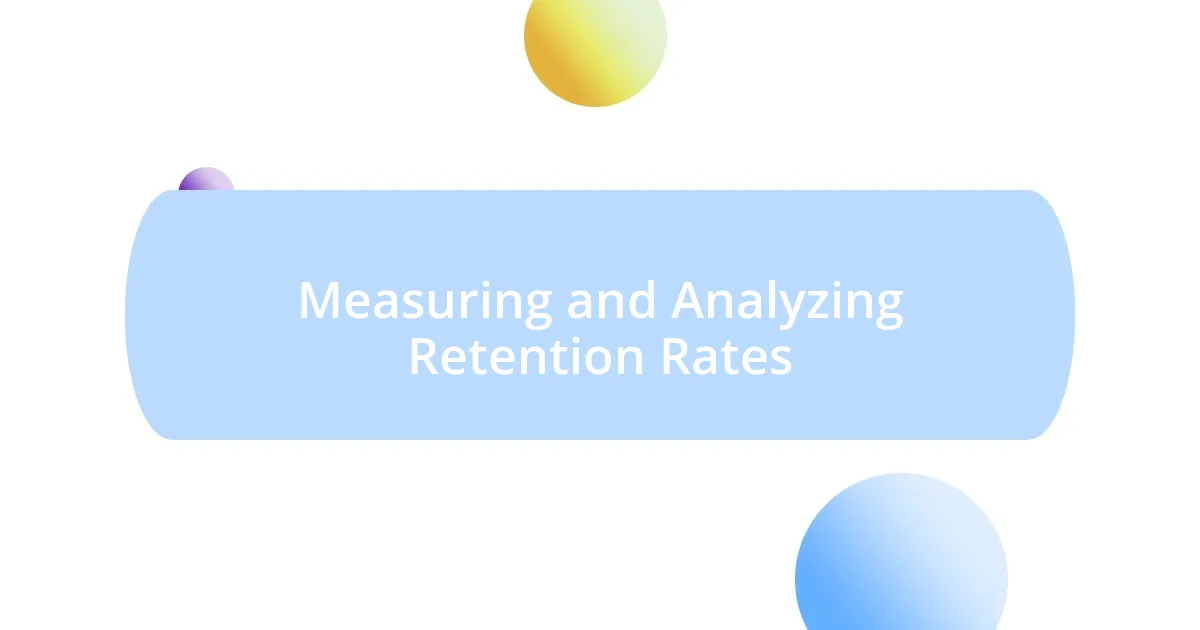Key takeaways:
- Donor retention is cost-effective and builds loyalty; appreciating donors can significantly enhance their commitment.
- Personalized communication and regular updates foster deeper connections and trust with donors.
- Utilizing data for insights allows for targeted strategies that enhance donor engagement and retention.
- Implementing creative recognition programs strengthens relationships, inspiring ongoing support and community engagement.

Understanding Donor Retention Importance
Donor retention is crucial for any nonprofit organization because it costs significantly more to acquire new donors than to keep existing ones. In my experience, when donors feel valued and connected, they are far more likely to contribute year after year. Have you ever thought about why you support a cause? It usually comes down to feeling like you’re part of something bigger, doesn’t it?
When organizations prioritize donor retention, they create an environment of trust and loyalty. I remember once receiving a heartfelt thank-you note from a nonprofit I supported. That simple gesture made me feel appreciated and more connected to their mission, prompting me to give again. Isn’t it fascinating how a small act can have a lasting impact?
Moreover, strong donor retention can lead to increased lifetime value of a donor. I’ve seen firsthand how loyal donors can transform an organization, not just financially but also by becoming advocates in their communities. When donors feel invested, they’re likely to share their passion with others – like ripples in a pond spreading outward. How can we harness those ripples to create meaningful relationships?

Key Strategies for Engaging Donors
When it comes to engaging donors, one standout strategy is personalized communication. I’ve found that taking the time to tailor messages can make all the difference. For instance, when I receive updates that reference my past donations or mention specific impacts of my contributions, I feel like my support genuinely matters. This kind of personal touch not only fosters a deeper connection but also keeps donors informed and invested in the mission.
Here are some key tactics to consider for better engagement:
- Personalized Thank-You Messages: Send handwritten notes or personalized emails that highlight the specific impact of their donation.
- Storytelling: Share powerful stories from beneficiaries that showcase the difference donors make, as this evokes an emotional response.
- Regular Updates: Keep donors informed about progress and future plans, making them feel involved in the organization’s journey.
- Exclusive Invitations: Offer donors early access or invites to events, creating a sense of community and belonging.
- Acknowledgment of Milestones: Celebrate donors’ anniversaries or achievements related to their contributions; this recognition reinforces their importance in your mission.
Engaging donors goes beyond simply asking for funds; it’s about building a lasting relationship. In my experience, when organizations show genuine appreciation and involve donors in their mission, the loyalty and support they receive in return can be truly remarkable. I recall one campaign where we celebrated the donors by sharing their stories publicly, and not only did their commitment deepen, but we also attracted new supporters eager to join our cause. It’s incredible how relationships can flourish when nurtured with attention and gratitude.

Building Strong Donor Relationships
Building strong relationships with donors starts with understanding their motivations. One time, I had a conversation with a long-term supporter who shared how her connection to our cause stemmed from a personal experience. This insight opened my eyes to the importance of listening and understanding the unique stories behind each donor. When we take the time to know our donors, we foster a sense of belonging that enhances their commitment to our mission.
Another key aspect is consistency in communication. I learned this the hard way after an organization I supported suddenly went quiet for months. The lack of updates made me question my impact and connection to their work. I’ve found that regular outreach, whether through newsletters, social media, or personal check-ins, establishes trust. By maintaining that line of communication, you remind donors they’re integral to your story, not just a name on a list.
Lastly, investing in donor appreciation is vital. I once attended an appreciation dinner where the impact of our contributions was highlighted through presentations and heartfelt testimonials from those we helped. The gratitude expressed by the organization was palpable. It’s these moments of recognition that reinforce to donors just how critical their support is. Building relationships isn’t just about maintaining contact; it’s about ensuring that donors feel valued and seen in every interaction.
| Technique | Impact on Donor Relationships |
|---|---|
| Personalized Communication | Enhances emotional connection and shows donors their significance |
| Consistency in Outreach | Builds trust and keeps donors engaged over time |
| Donor Appreciation Events | Reinforces the value of donor contributions and fosters loyalty |

Utilizing Data for Donor Insights
Utilizing data for donor insights can truly revolutionize how organizations engage with their supporters. I remember when my team analyzed giving patterns, revealing unexpected trends about donor preferences. By leveraging these insights, we were able to create targeted campaigns tailored specifically to donor interests, which not only increased contributions but also deepened their emotional connection to our cause. Isn’t it fascinating how data can transform relationships, turning mere statistics into meaningful narratives?
Moreover, segmentation based on data analysis can drive significant improvements in communication strategies. For instance, I once worked with a nonprofit that segmented its donor list into different categories, such as first-time donors, long-term supporters, and major contributors. This allowed us to craft messages that resonated more deeply with each group. The results were astonishing; we saw increased engagement from all segments. Have you considered how segmenting your donors might enhance your outreach efforts?
Lastly, tracking donor interactions helped us identify those needing a little extra attention. I recall reaching out to a specific donor who hadn’t engaged in a while, fueled by data that indicated her declining interaction. When I reached out personally, we uncovered her reasons and adapted our approach. This sparked a renewed commitment from her, illustrating the power of truly listening and responding to donor needs. When was the last time you utilized data to reach out meaningfully to your supporters?

Implementing Donor Recognition Programs
Implementing donor recognition programs is a powerful way to express gratitude and foster long-lasting relationships. I remember hosting a small event for our top donors, where we showcased their contributions through stories and visuals. The joy on their faces was telling; it wasn’t just about the recognition; it was the acknowledgment that their support genuinely made a difference. Have you ever felt that rush when your efforts are spotlighted? That’s the magic of recognition.
Beyond events, creative recognition methods can make a lasting impression. I’ve seen organizations send personalized thank-you notes or small gifts that reflect the donor’s interests. One time, I received a hand-painted card from a charity I supported, along with a small plant. It felt special and personal, like they truly knew me. When donors feel appreciated, they’re more likely to continue their support. Isn’t it amazing how a simple gesture can strengthen a bond?
Another idea I’ve found effective is highlighting donors in newsletters or on social media. In my experience, a heartfelt post thanking a donor not only honors them but also inspires others to give. I recall one organization featuring a donor’s story on their website, resulting in a surge of new supporters who resonated with that person’s journey. This ripple effect of recognition can lead to deeper community engagement and inspire loyalty. How do you currently celebrate your donors’ contributions?

Measuring and Analyzing Retention Rates
Measuring retention rates effectively begins with gathering quantitative data over time. I’ve found that tracking year-over-year donor retention statistics can unveil minor shifts that reveal larger trends. For instance, when I analyzed a particular campaign, I noticed a 10% drop in returning donors. This prompted an investigation into possible causes, opening a pathway to improvement.
Analyzing this data is just as crucial as measuring it. I once conducted a retention analysis after noticing a decline in my nonprofit’s sustaining donors. By cross-referencing their giving history with engagement metrics, I discovered that many had not received acknowledgment for their contributions. This revelation inspired me to enhance our stewardship practices, resulting in a renewed interest from those very donors. Have you taken the time to dissect your data for hidden patterns that could help strengthen your relationships?
Additionally, I’ve always valued segmenting retention analyses by donor demographics. When I broke down statistics based on age groups and giving levels, it was like unveiling a roadmap for future outreach. For example, younger donors tended to engage differently compared to older ones. By tailoring my approach to resonate with each group, I saw a significant boost in re-engagement efforts. Isn’t it exciting to think about the stories your data can tell when you dig deeper?

Adapting Techniques for Continuous Improvement
Adapting techniques for continuous improvement requires that we remain flexible and responsive to what our data tells us. I’ve learned to embrace feedback and use it to adjust my strategies regularly. For instance, after a donor survey revealed that supporters valued more frequent updates, I made it a priority to enhance our communication frequency. How often do you reevaluate your engagement techniques based on donor input?
One of the most impactful shifts I experienced was when I started implementing small test campaigns to experiment with new approaches. I remember trying out a monthly giving program, initially taking it slow and gauging reactions through targeted emails. The excitement from donors who joined at the early stages was palpable. It led me to refine our messaging and ultimately resulted in a rich influx of recurring gifts. Have you ever tested new initiatives to see what truly resonates with your audience?
To keep techniques relevant, I’ve found it beneficial to stay engaged with industry trends and innovations. Following sector leaders on social media and participating in webinars has opened my eyes to fresh ideas. I recall attending a workshop where someone shared their success with video storytelling; that inspired me to create a series highlighting our beneficiaries. The emotional connection forged through that personal storytelling significantly boosted donor engagement. What innovative ideas have you discovered recently that could enhance your efforts?














